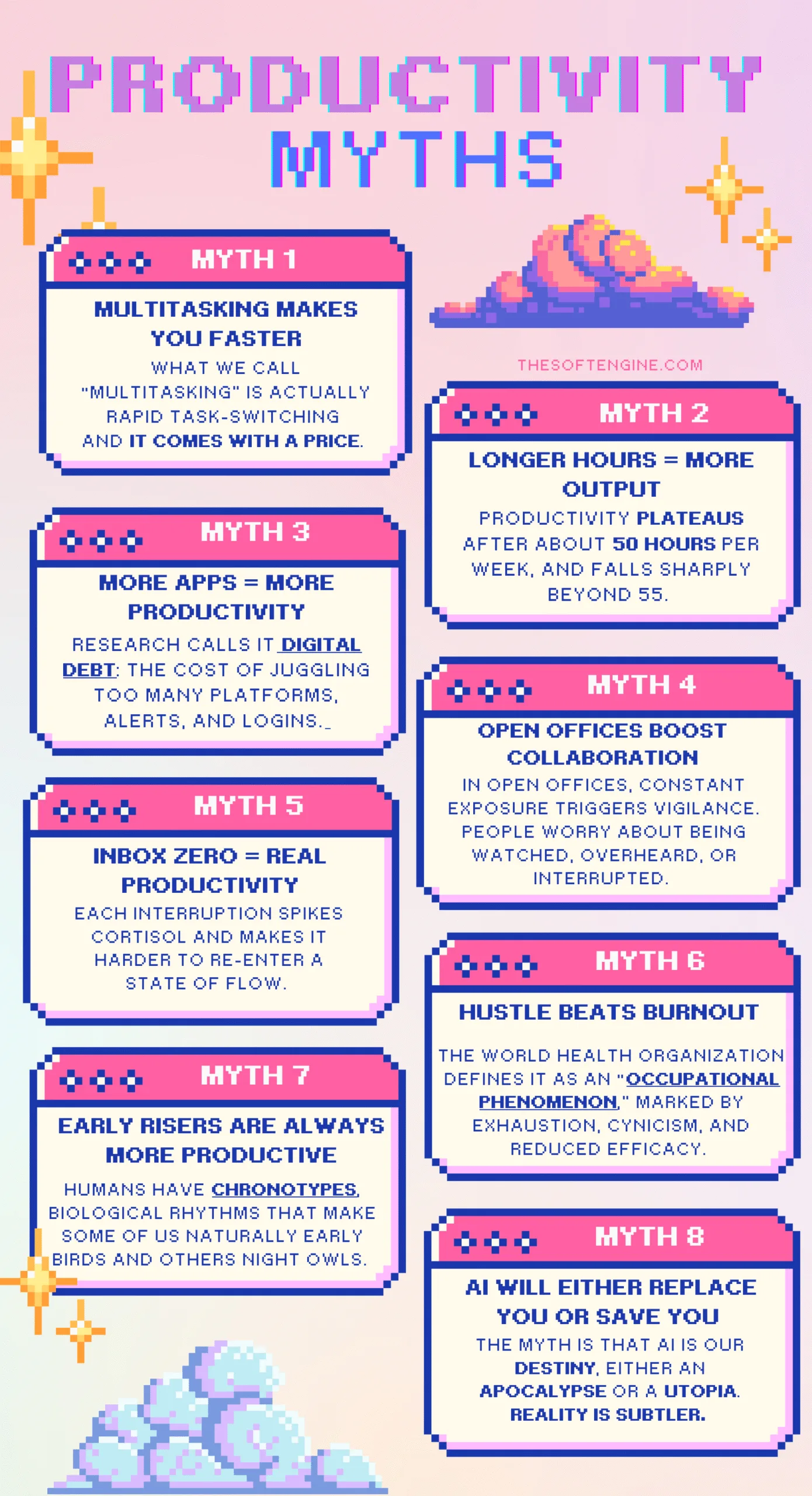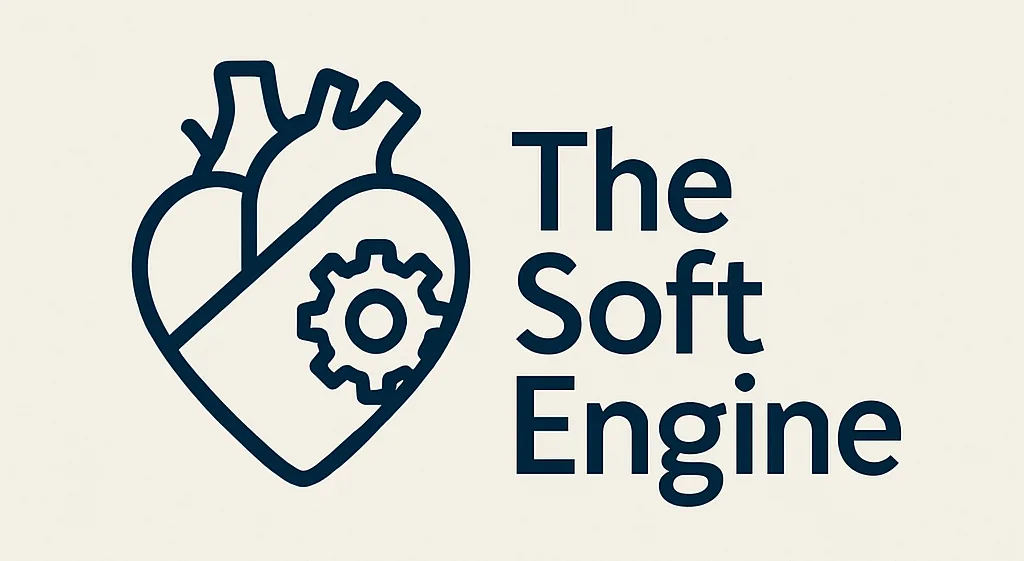Productivity Myths: Table of Contents
We live in an age obsessed with productivity. Apps promise to make us faster. Gurus sell morning routines as magic bullets. Hustle culture tells us to grind harder, while corporate culture drowns us in meetings and metrics.
Yet for all the hacks and hours, many of us end our days with the same question: Why didn’t I get to the work that really mattered?
The truth is, we’re still carrying around myths about productivity, stories we inherited from factories, from hustle culture, from the early internet, that don’t stand up to evidence.
They feel intuitive. They look good on paper. But in practice, they create busyness without progress, stress without results.
This guide pulls apart the most persistent productivity myths, traces what the science actually says, and offers practical alternatives you can try this week.
The Biggest Productivity Myths (and What to Do Instead)
We’ve been told these stories for so long that they feel like common sense. The science and lived experience say otherwise.
Myth #1: Multitasking Makes You Faster
Today, multitasking feels inevitable. The constant hum of Slack, Zoom, email, and notifications makes it seem like juggling tasks is a skill worth mastering.
Popular culture even praises “multitaskers” as hyper-efficient achievers.
The science says otherwise. The brain isn’t wired to run parallel tasks, especially when both require active thinking.
What we call “multitasking” is actually rapid task-switching – and it comes with a price.
Studies from the American Psychological Association show that switching between tasks creates measurable “switching costs” – lost seconds that add up to hours across a week.
Rubinstein, Meyer, and Evans (2001) found that performance dropped significantly when participants alternated between cognitive tasks compared to focusing on one at a time.
MRI scans confirm that the prefrontal cortex, responsible for decision-making, has a limited bandwidth and experiences bottlenecks under multitasking conditions.
Do this instead:
- Batching tasks. Group similar activities (like emails or calls) into dedicated windows.
- Deep work blocks. Protect 60–90 minutes daily for high-value tasks without digital interruptions.
- Use tools wisely. Apps like Freedom or Focus To-Do can help shut down digital noise.
Some light multitasking (like folding laundry while on an audio call, or background music during work) doesn’t strain cognition. The problem lies in splitting active attention between complex tasks.
Myth #2: Longer Hours = More Output
For more than a century, the work ethic has been tied to hours logged.
“Burning the midnight oil” became synonymous with ambition. Modern hustle culture reinforces the idea that long hours are the only route to success.
The truth is, productivity doesn’t scale linearly with time.
Economist John Pencavel at Stanford demonstrated that productivity plateaus after about 50 hours per week, and falls sharply beyond 55.
The World Health Organization linked long working hours (55+ per week) to a 35% higher risk of stroke and 17% higher risk of heart disease.
Beyond a point, longer hours don’t just hurt output. They just harm your health.
This isn’t new. Henry Ford, in the 1920s, reduced his factory workers’ schedule from 60 to 40 hours and found that productivity actually increased.
Today, Japan’s culture of overwork (karoshi, or “death by overwork”) is a stark warning of what happens when hours are treated as the ultimate measure of value.
Do this instead:
- Cap hours. Track real outcomes instead of presenteeism.
- Guardrails. Use time-tracking apps like Clockify to visualize when performance dips.
- Cultural reset. Leaders should measure productivity better: what got done, not who stayed the latest.
Some industries (like healthcare or crisis response) demand long hours occasionally. But those exceptions must be paired with systemic recovery time, or risk permanent burnout.
Myth #3: Early Risers Are Always More Productive
The “5 a.m. club” is one of the most marketed productivity hacks of the past decade. Books and influencers preach that waking before dawn unlocks discipline, clarity, and success.
It’s seductive because it feels like a moral advantage: if you can beat the sunrise, you’ve beaten the competition.
The truth is a lot more nuanced. Humans have chronotypes, biological rhythms that make some of us naturally early birds and others night owls.
Research by Till Roenneberg (2019) shows that when people’s work schedules align with their natural circadian rhythm, they report better performance and well-being.
Forcing everyone into an early-bird mold creates “social jetlag,” a mismatch between biological clocks and work demands.
Morning people may perform better in tasks requiring focus before noon, while evening types often excel later in the day.
Forcing night owls into a 5 a.m. routine leads to sleep deprivation, stress, and diminished productivity. This has implications for schools, shift work, and remote teams across time zones.
Do this instead:
- Experiment. Track your energy for two weeks; notice when you feel sharpest.
- Flex schedules. Employers offering flexible start times often see higher satisfaction and output.
- Leverage tools. Sleep trackers like Oura or Rise can help map personal peaks.
While early rising can be beneficial in certain contexts (such as quiet hours or fewer distractions), it’s only a productivity booster if it aligns with your natural biology.
Copying someone else’s morning routine is not a guarantee of success.
Myth #4: Open Offices Boost Collaboration
The logic feels airtight: take away walls and doors, and people will naturally talk more.
Silicon Valley cemented this image—the buzzing open-plan office with whiteboards, beanbags, and “accidental collisions” of ideas.
The collisions happened, but not the way leaders hoped.
A landmark study in PNAS tracked two Fortune 500 companies that moved to open-plan layouts. Face-to-face interaction plummeted by 70%, while digital messaging spiked. Instead of collaborating more, employees withdrew into headphones and Slack.
Humans need both connection and control. In open offices, constant exposure triggers vigilance. People worry about being watched, overheard, or interrupted.
Collaboration gets replaced with performative busyness. Instead of free-flowing creativity, you get quieter conversations shoved into private channels.
Do this instead:
- Design variety. Offer zones: quiet for focus, open for brainstorms, small rooms for 1:1s.
- Write the rules. A short “when to DM, when to meet” playbook saves endless friction.
- Signal respect. Even simple “do not disturb” flags or desk lights cut interruption costs.
Myth #5: Inbox Zero = Real Productivity
Nothing feels cleaner than an empty inbox. It’s the digital equivalent of a spotless desk.
Productivity gurus turned “Inbox Zero” into a badge of honor, as if the number of unread emails is the ultimate measure of accomplishment.
Email is powerful, but dangerous when treated as a to-do list.
Pew Research shows workers still rank it as the most essential digital tool for their jobs. But UC Irvine’s Gloria Mark found that eliminating email for just five workdays lowered stress and multitasking dramatically.
Each interruption spikes cortisol and makes it harder to re-enter flow. The kicker: an inbox at zero doesn’t mean high-value work is done—just that messages were cleared.
Email throughput is communication throughput, not business impact. It’s easy to confuse fast replies with progress, but projects live and die in context-rich systems, not scattered threads.
Do this instead:
- Batch it. Check email 2–3 times a day. Outside those windows, mute alerts.
- Move work out. Track decisions and deliverables in project tools, not email chains.
- Subject with clarity. “[DECISION NEEDED]” beats “Quick Question” every time.
Myth #6: More Apps = More Productivity
Every bottleneck looks like a tool problem. Can’t track tasks? There’s an app. Can’t manage time? Another app.
Overwhelmed by notifications? Ironically, yet another app. The marketplace feeds the belief that the right tool will finally unlock productivity nirvana.
Research calls it digital debt: the cost of juggling too many platforms, alerts, and logins.
Microsoft’s 2023 Work Trend Index found that workers spend nearly 60% of their time on “digital communication” (apps, messages, notifications), leaving less than half for actual creation and problem-solving.
The more fragmented the tool stack, the less time is left for real work.
The reality? Adding apps often increases overhead. Each new platform brings training, duplication, and yet another inbox to manage.
The right app can be transformative. The wrong one just adds another ping.
Do this instead:
- Consolidate. Pick one “home base” (Notion, Coda, Asana) and move scattered processes there.
- Audit monthly. Kill or merge apps that duplicate functions.
- Set norms. Decide where decisions live—Slack, email, or project tool—and stick to it.
Myth #7: Hustle Beats Burnout
Hustle stories are romantic. We admire the entrepreneur coding 18 hours a day, the manager answering emails at midnight.
Grind became a badge of honor, proof of your toughness and ambition. But if it’s so great, why is burnout such a common issue?
Burnout is not a personal weakness, but it’s a systemic failure.
The World Health Organization defines it as an “occupational phenomenon,” marked by exhaustion, cynicism, and reduced efficacy.
Gallup’s State of the Global Workplace 2024 estimates low engagement (much of it linked to burnout) costs the world economy $8.9 trillion, about 9% of GDP.
Short sprints of hustle can be energizing if followed by recovery. The myth is that hustle can be a permanent operating system.
Do this instead:
- Redesign workloads. Limit “work in progress” and enforce real downtime.
- Protect boundaries. Create no-meeting focus blocks and after-hours communication norms.
- Pair perks with policy. Meditation apps are fine—but only if paired with workload reform.
Myth #8: AI Will Either Replace You or Save You
AI headlines swing between extremes: either robots take all the jobs, or they free us to “focus on what matters.”
The myth is that AI is our destiny, either an apocalypse or a utopia. Reality is subtler.
Studies show AI is most powerful as a collaborator, not a replacement.
In a deployment with 5,000+ customer support agents, AI increased issues resolved per hour by 14%, with the biggest gains for novices.
Controlled experiments found professionals using AI for writing tasks finished 40% faster with ~20% higher quality. UK government pilots of Microsoft Copilot saved staff an average of 26 minutes per day.
AI boosts routine drafting, summarization, and pattern recognition. But human judgment, creativity, and ethics remain irreplaceable.
Without effective prompts, training, and governance, AI becomes another source of noise.
Do this instead:
- Think in workflows. Map tasks from intake → draft → review → deliverable. Insert AI where it reduces load.
- Keep humans in the loop. AI drafts; people judge.
- Measure impact. Use cycle time, first-pass quality, and rework rate to check if AI helps or hinders.

Conclusion
Every era invents its own myths about productivity. The factory age worshipped hours. The digital age worshipped inbox zero.
Today, we’re told to hustle endlessly or that AI will magically fix everything.
The history of productivity and the research tell a different story. Productivity gains come not from working more, but from working smarter: respecting rhythms, reducing noise, designing recovery, and using tools as servants, not masters.
You don’t need to dismantle all the myths at once. Start small:
- Protect one deep-work block.
- Cancel a pointless meeting.
- Batch your email.
- Try a mini four-day week sprint.
Curious where your time and focus are really going?
Take the Soft Engine Productivity Assessment today and see your blind spots, then learn how to turn them into breakthroughs.

